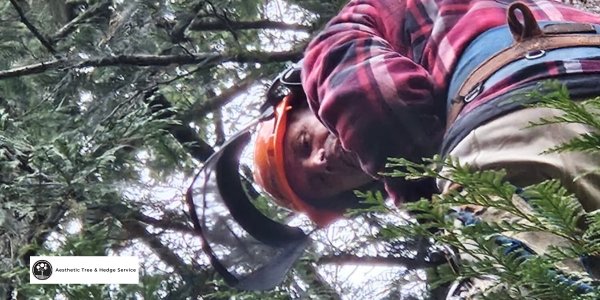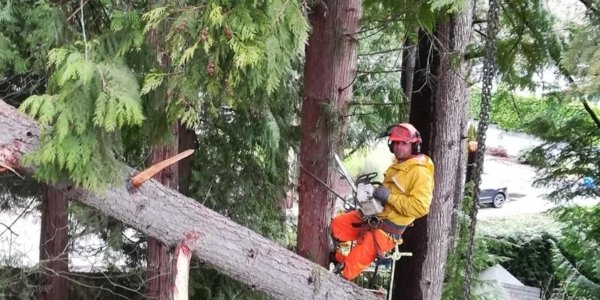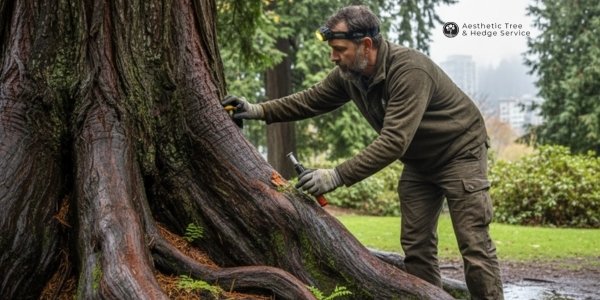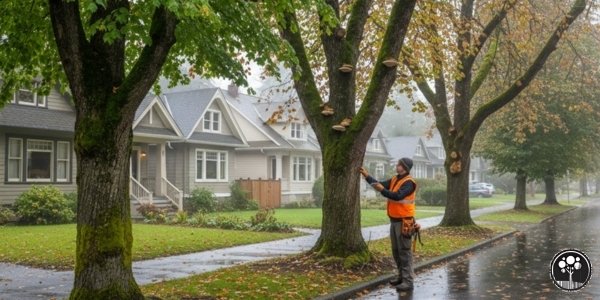As climate change affects weather patterns, homeowners are seeing more extreme weather events, including bigger and more intense storms. Bigger storms can be a real threat to your trees, causing branches to fall, trees to uproot and property damage. Preparing your trees for storm risk is not only good for your landscape but also your home and surrounding areas.
In this post we’ll cover how to protect your trees from storm damage, best practices for tree strengthening and when to call an arborist.
1. Larger Storm Risks and Their Impact on Trees
Larger storm risks are a big threat to trees, especially those that are weakened or poorly maintained. High winds, heavy rain, snow and ice can all cause damage, especially to older trees or those with structural issues.
- Wind damage: Strong winds during storms can break branches, make trees lean or uproot them completely. Trees with weak branch structures are more prone to splitting or falling under high winds.
- Heavy rain and flooding: Excessive rain can saturate the soil making it less stable and more likely for trees to topple over. Trees with shallow root systems are more vulnerable during storms with heavy rainfall.
- Snow and ice buildup: During winter storms, snow and ice can accumulate on tree branches, adding weight and causing them to snap. This is especially dangerous for trees with dense canopies that can hold more snow and ice.
- Lightning strikes: Trees are also at risk of being struck by lightning during thunderstorms which can cause immediate damage or long term health issues if the tree is not properly treated afterwards.
Now that you know how storms can affect your trees, you can prepare for the worst and take proactive steps to reduce the impact of these larger storm risks.
2. How to Strengthen Trees
One of the best ways to prepare your trees for larger storm risks is to strengthen them through proper care. Regular tree care means your trees are better equipped to handle extreme weather.
- Pruning and trimming: Regular pruning of dead, weak or over extended branches is crucial in reducing storm damage. Pruning not only removes potential hazards but also promotes stronger growth by allowing more light and air to reach the inner parts of the tree.
- Cabling and bracing: For trees with weak branch unions or heavy limbs, cabling and bracing can help reinforce the structure and prevent branches from breaking during storms. These supports distribute the weight more evenly and add stability.
- Deep watering and mulching: Keep your trees well watered and mulched to maintain a strong root system. Deep watering encourages roots to grow deeper into the soil making trees more wind resistant and soil erosion resistant. Mulch retains moisture and protects the roots from temperature extremes.
- Proper spacing: If you’re planting new trees, make sure to give them enough space to grow. Trees that are too close together will compete for resources and will have weaker structures and more vulnerable during storms.
Strengthening your trees through regular maintenance not only helps them survive larger storm risks but also long term health and beauty in your landscape.
3. Trees at Risk During Larger Storms
Not all trees are created equal when it comes to larger storm risks. Identifying trees that are most vulnerable during storms is key to preventing damage. Here are the signs to look out for:
- Leaning trees: A tree that’s already leaning or showing signs of instability is more likely to fall during a storm. Leaning can be caused by weak root system, soil erosion or previous storm damage.
- Cracks in the trunk: Cracks or splits in the trunk means the tree’s structure is compromised. Trees with visible cracks are more prone to breaking under strong winds.
- Dead or diseased branches: Dead or decaying branches are more likely to snap during a storm and can be a hazard to nearby structures or people. Remove these branches before a storm hits.
- Root damage: Trees with damaged or exposed roots are more likely to be uprooted during storms. Root damage can be caused by construction, soil erosion or pests and weakens the tree’s ability to anchor itself to the ground.
Look for these signs in your trees and take action before the storm hits.
4. Post Storm Tree Care: Check and Repair
After the storm has passed, check your trees for damage and repair them. Post storm care can make a big difference in a tree’s long term health and prevent future storm risks.
- Check for damage: Walk around your property and check trees for broken branches, leaning trunks or uprooted. If you see major damage like large limbs fallen or cracks in the trunk, address these as soon as possible.
- Prune damaged branches: If only minor branches are damaged, you can prune them yourself to prevent further stress to the tree. Just make sure to use proper pruning techniques to not damage the tree further.
- Re-stake young trees: For newly planted trees that were affected by the storm, re-staking may be needed to help them regain stability. Use flexible ties to not restrict the tree’s natural movement.
- Check root health: If a tree was partially uprooted, it may still be savable by repositioning and securing the roots. But this should only be done by a professional arborist to get the best result.
Check and repair storm damage and your trees will recover and be back to thriving after the storm.
5. When to Call an Arborist for Larger Storm Risks
While regular tree maintenance can protect your property from larger storm risks, there are times to call an arborist. Arborists are trained to assess tree health, fix structural issues and provide expert care to ensure long term safety and stability of your trees.
Here are the times to call an arborist:
- Severe storm damage: If a tree has major damage like large broken limbs or cracks in the trunk, an arborist can determine if the tree can be saved or if it needs to be removed for safety.
- Tree removal: If a tree is a hazard to nearby structures or people, an arborist can remove it safely and prevent further damage. This is especially important if the tree is leaning, uprooted or decaying.
- Cabling and bracing: For trees with heavy limbs or weak branches, an arborist can install cabling and bracing to support the tree during future storms. This is a preventative measure to save the tree from breaking and withstand larger storm risks.
- Routine inspections: Scheduling regular inspections with an arborist is the best way to ensure your trees are healthy and storm ready. Arborists can identify hazards and give you recommendations on how to maintain the strength and stability of your trees.
Larger Storm Risks
As weather patterns change, preparing your trees for larger storm risks is more important than ever. By pruning, watering and maintaining your trees you can reduce storm damage and protect your landscape and property.
If you have concerns about your trees or need help getting them storm ready, contact Aesthetic Tree today! Our certified arborists will help you protect your trees and keep them strong and healthy for larger storm risks.





